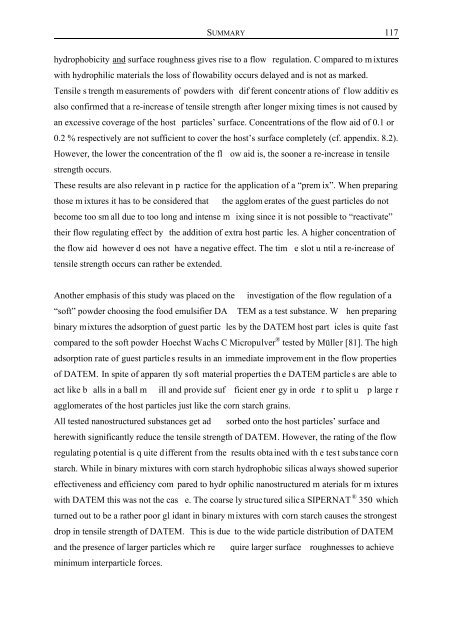Untersuchungen zur - OPUS - Universität Würzburg
Untersuchungen zur - OPUS - Universität Würzburg
Untersuchungen zur - OPUS - Universität Würzburg
Erfolgreiche ePaper selbst erstellen
Machen Sie aus Ihren PDF Publikationen ein blätterbares Flipbook mit unserer einzigartigen Google optimierten e-Paper Software.
SUMMARY<br />
hydrophobicity and surface roughness gives rise to a flow regulation. C ompared to m ixtures<br />
with hydrophilic materials the loss of flowability occurs delayed and is not as marked.<br />
Tensile s trength m easurements of powders with dif ferent concentr ations of f low additiv es<br />
also confirmed that a re-increase of tensile strength after longer mixing times is not caused by<br />
an excessive coverage of the host particles’ surface. Concentrations of the flow aid of 0.1 or<br />
0.2 % respectively are not sufficient to cover the host’s surface completely (cf. appendix. 8.2).<br />
However, the lower the concentration of the fl ow aid is, the sooner a re-increase in tensile<br />
strength occurs.<br />
These results are also relevant in p ractice for the application of a “prem ix”. When preparing<br />
those m ixtures it has to be considered that the agglom erates of the guest particles do not<br />
become too sm all due to too long and intense m ixing since it is not possible to “reactivate”<br />
their flow regulating effect by the addition of extra host partic les. A higher concentration of<br />
the flow aid however d oes not have a negative effect. The tim e slot u ntil a re-increase of<br />
tensile strength occurs can rather be extended.<br />
Another emphasis of this study was placed on the investigation of the flow regulation of a<br />
“soft” powder choosing the food emulsifier DA TEM as a test substance. W hen preparing<br />
binary mixtures the adsorption of guest partic les by the DATEM host part icles is quite fast<br />
compared to the soft powder Hoechst Wachs C Micropulver ® tested by Müller [81]. The high<br />
adsorption rate of guest particles results in an immediate improvement in the flow properties<br />
of DATEM. In spite of apparen tly soft material properties th e DATEM particle s are able to<br />
act like b alls in a ball m ill and provide suf ficient ener gy in orde r to split u p large r<br />
agglomerates of the host particles just like the corn starch grains.<br />
All tested nanostructured substances get ad sorbed onto the host particles’ surface and<br />
herewith significantly reduce the tensile strength of DATEM. However, the rating of the flow<br />
regulating potential is q uite different from the results obtained with th e test substance corn<br />
starch. While in binary mixtures with corn starch hydrophobic silicas always showed superior<br />
effectiveness and efficiency com pared to hydr ophilic nanostructured m aterials for m ixtures<br />
with DATEM this was not the cas e. The coarse ly structured silica SIPERNAT ® 350 which<br />
turned out to be a rather poor gl idant in binary mixtures with corn starch causes the strongest<br />
drop in tensile strength of DATEM. This is due to the wide particle distribution of DATEM<br />
and the presence of larger particles which re quire larger surface roughnesses to achieve<br />
minimum interparticle forces.<br />
117

















